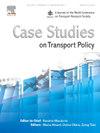Premature casual carpooling in Texas: analyzing customer churn in the Metropia experiment with survival analysis and machine learning
IF 3.3
Q3 TRANSPORTATION
引用次数: 0
Abstract
This study makes a timely contribution to peer-to-peer mobility research by employing a hybrid analytical framework that integrates survival analysis (Cox Proportional Hazards model) with advanced machine learning techniques (XGBoost and SHAP values) to uncover nuanced patterns of user churn in the Metropia app. The Metropia experiment, a peer-to-peer carpooling program, was conducted in Austin and El Paso, TX, with a sample of 3,227 users who first engaged with the app between January 1, 2016, and December 31, 2018. By connecting sociodemographic factors, trip characteristics, and app incentives to user retention, this study offers a data-driven view of behavior on mobility platforms. Results show that older users, females, and telecommuters are more likely to stay, while higher-income households, larger families, long commutes, and experienced drivers show higher churn. Several app features show complex, non-linear effects on disengagement. Interpreted through the lenses of transaction cost economics, network effects, and prospect theory, these findings highlight the importance of reducing perceived user costs and enhancing value through thoughtful app design. The study not only identifies critical behavioral and structural challenges facing casual carpooling but also sheds light on its premature development stage. It offers actionable insights for platform developers and planners to enhance engagement and retention, while calling on local governments to support shared mobility through strategic policy and urban design. This research ultimately advances the discourse on sustainable urban transportation and the future of the sharing economy.
德克萨斯州过早的随意拼车:用生存分析和机器学习分析大都会实验中的客户流失
本研究采用混合分析框架,将生存分析(Cox比例风险模型)与先进的机器学习技术(XGBoost和SHAP值)相结合,为点对点移动研究做出了及时的贡献,揭示了metrotropia应用程序中用户流失的细微模式。metrotropia实验是一个点对点拼车项目,在德克萨斯州的奥斯汀和埃尔帕索进行,样本为3227名在2016年1月1日期间首次使用该应用程序的用户。2018年12月31日。通过将社会人口因素、旅行特征和应用程序激励与用户留存联系起来,本研究提供了一个数据驱动的移动平台行为视图。结果显示,年龄较大的用户、女性和远程工作者更有可能留下来,而高收入家庭、大家庭、长通勤时间和经验丰富的司机则表现出更高的流失率。一些应用功能显示出复杂的、非线性的脱离效果。通过交易成本经济学、网络效应和前景理论的解读,这些发现强调了通过深思熟虑的应用设计来降低感知用户成本和提升价值的重要性。这项研究不仅确定了随意拼车面临的关键行为和结构挑战,还揭示了它的早期发展阶段。报告为平台开发商和规划者提供了可操作的见解,以提高参与度和留存率,同时呼吁地方政府通过战略政策和城市设计支持共享出行。本研究最终推动了可持续城市交通和共享经济未来的讨论。
本文章由计算机程序翻译,如有差异,请以英文原文为准。
求助全文
约1分钟内获得全文
求助全文

 求助内容:
求助内容: 应助结果提醒方式:
应助结果提醒方式:


